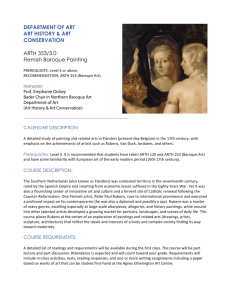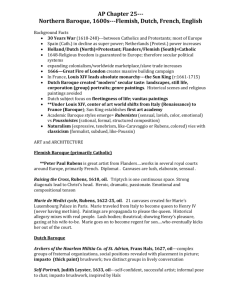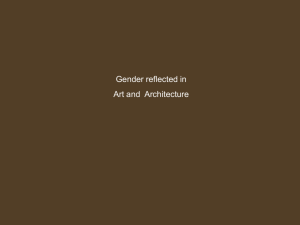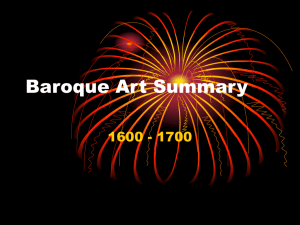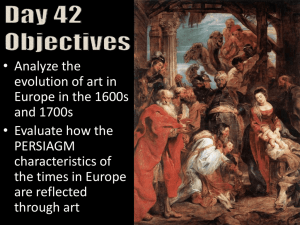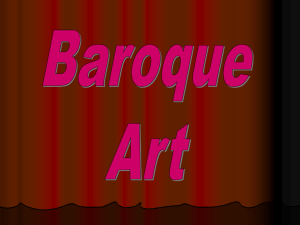Ch 25 Cue Cards Due
advertisement
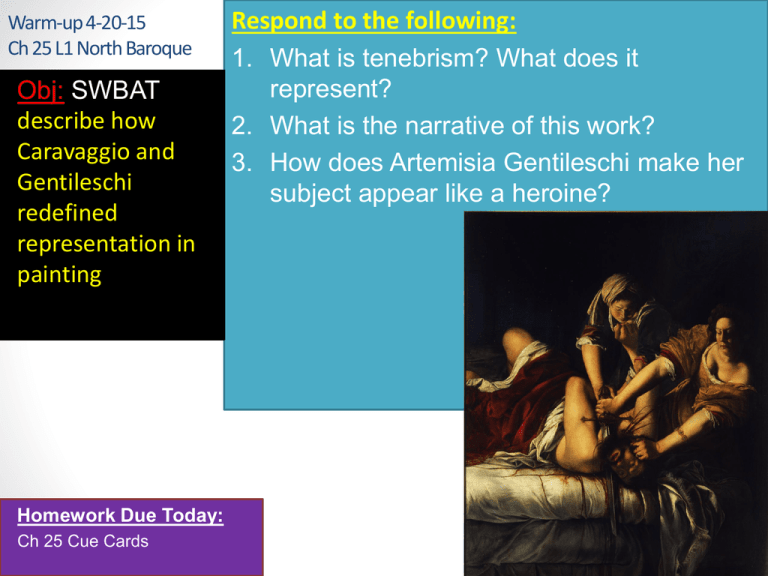
Warm-up 4-20-15 Ch 25 L1 North Baroque Obj: SWBAT describe how Caravaggio and Gentileschi redefined representation in painting Homework Due Today: Ch 25 Cue Cards Respond to the following: 1. What is tenebrism? What does it represent? 2. What is the narrative of this work? 3. How does Artemisia Gentileschi make her subject appear like a heroine? Artemesia Gentileschi: Judith Slaying Holofernes 2 Caravaggi-oh no you did’ nt! Tenebrism—sharply lit scenes with a single light source and dark background Meaning? Christ as the light of the world Caravaggio: Judith Slaying Holofernes FEMALE ARTIST: Artemesia Gentileschi: Judith Slaying Holofernes Caravaggista Raped at age 19 Became 1st female painter at Florence Academy of Design 3 Narrative: Judith, (old testament heroine ) helps free Israel by seducing an Assyrian general. When inside his tent, she cuts off his head with his sword Judith gains physical/emotional strength to sever a head, Blood spurts out b/c heartbeat Renders HEROINE instead of the common heroes. Triumph of women over men FIGURE 24-21 ARTEMISIA GENTILESCHI, JUDITH SLAYING HOLOFERNES, CA. 1614–1620. OIL ON CANVAS, 6’ 6 1/3” X 5’ 4”. GALLERIA DEGLI Due Today: Ch 25 Cue Cards PAST DUE: •Ch 24 Cue Cards (23 Cards) •Ch 23 Cue Cards—15 total •Ch 23 Response Questions •HW Responses: Garden of Earthly Delights Future Due Dates: Chapter 23 Cue Cards due Announcements: Tues & Thurs—After School Study Sessions Thur 5/7—AP AH Exam Sat 5/2—Mock Exam, feedback session Pay $5 to student store for your AP Test Homework: Due Wed 4/23 : Ch 26 Cue Cards Office Hours Tuesday 3:00-4:00 Thursday 3:00-4:00 SPRING BREAK 1 month to the test Written Quiz After School Study Community Awareness Fair @lunch After School Ch 25 Cue Cards Due After School After School After School After School Dance Orientation Ch 24 Cue Cards Due Dance Auditions Carnival on Campus $15 presale AP Parent Night Carnival on Campus $15 presale End of 3rd Quarter After School Chapter 25 - The Baroque in Northern Europe • Explain why Baroque art in Flanders is more closely tied to the Baroque art of Italy than is the art of much of the rest of northern Europe. • Describe the role of Peter Paul Rubens in Flemish art and also in other sphere of life in Flanders. • Explain why painting in the Dutch Republic favored private commissions of portraits, genre scenes, landscapes, and still lifes rather than the more traditional religious works of the previous century. • Give reasons for the abundance of luxury items represented in Dutch painting, especially fine clothing and jewelry in portraits. • Describe the work and career of Rembrandt van Rijn and be certain to include reasons for his apparent failure as a business person at the end of his life. • Describe instances of pronounced kingly influence on art and architecture is some parts of Europe. • Explain how classical ideas and ideals survived in Northern Europe during the Baroque; in what country is the survival most notable. • Explain why architecture was the most important art form in England during 6 the 17th century. Start memorizing these dates!! HOMEWORK DUE TUES 4-21-15 1. What historical factors account for the large demand for secular artworks, including genre scenes, still lifes, portraits and landscapes in the Dutch Republic in the 17th century? 2. How does Gerrit van Honthorst’s “Supper Party” represent middle class patronage? 3. Describe Rembrandt’s innovation in rendering light, in both paintings and in prints. 4. Describe Jan Vermeer’s style and subject matter. What is camera obscura? How did Vermeer use camera obscura? 17TH CEN (1600S) BAROQUE IN EUROPE Baroque Essentials (South & North) Complex—narrative/artistic skill Still Life—inanimate objects Moral Symbolism—vanitas, portraits Grand Scale—architecture, sculpture Ornamentation Light—dramatic lighting Drama—climatic moments Northern Bourgeois Baroque: “Golden Age” (merchant middle class butchers, bakers, & shoemakers) • Dutch Republic = Protestant nation without an absolute ruler • Lacking commissions from Catholic church, Dutch artists turn to merchant class for commissions • Specialized in PORTRAITURE and STILL-LIFE • Portraiture (especially of groups) new ways of capturing a new class of patrons…Calvinists (who did NOT believe in religious imagery) • Still-Life way for middle class Dutch to show pride in their accomplishments AND transience (short, not lasting) of material things 11 Dutch Republic: Pieter Claez- Vanitas (Still Life) 1630s •Vanitas - still life reminds viewers of the transience (short, not lasting) of “vanity”. materialism, reminder that death is ever-present •Reveals Dutch pride in accomplishments depiction of material goods (worldwide trade) •For Calvinist patrons, did not believe in overt religious imagery (protestant) •still life reminds viewers of the transience of “vanity,” materialism. Reminder that death is ever-present • Interest in scientific accuracy • Objects have meaning: time, human achievement • momento mori= reminder of mortality/death. • artist memorialized himself in the painting 12 13 RACHEL RUYSCH, Flower Still Life CFU 1. How does this work represent Calvinist beliefs? Vanitas - still life reminds viewers of the transience of “vanity” Beauty is fleeting, should not be the focus of life 2. How does this work represent Dutch achievements? Botany Dutch were growers and exporters of flowers Scientific accuracy 14 RACHEL RUYSCH, Flower Still Life Figure 24-57 RACHEL RUYSCH, Flower Still Life, after 1700. Oil on canvas, 2’ 6” x 2’. The Toledo Museum of Art, Toledo (purchased with funds from the Libbey Endowment, gift of Edward Drummond Libbey). 15 16 Peter Paul Rubens Elevation of the Cross –Flanders (Catholic) Aristocrat w/ royal patrons, International star. Themes: Religion and Passion “Pan-European Style” --Combines Italian and Northern painting traditions Narrative: Christ nailed to cross, muscular figures lifting cross Strenuous exertion, physical and emotional tension and struggle 17 Peter Paul Rubens Elevation of the Cross –Flanders (Catholic) 3. In terms of style, What’s Italian Renaissance or Baroque? • Diagonals, dynamic comp., intense emotion, action and light of Caravaggio • Twisting poses, muscular bodies heroicism like…Michelangelo’s Sistine Chapel, classical drapery 4. In terms of style, What’s Northern? • Rich colors, surface textures and details 19 20 Exit Slip: Describe Peter Paul Ruben’s PanEuropean style. 21 Peter Paul Rubens Marie de’ Medici (widow of King Henry IV) commissioned Rubens to paint the story of her life Narrative: her arrival in France Use of allegory (of France) • “fleur-de-lis-man”, • winged “fame” above, • Sea and sky rejoice at her safe arrival from Italy • Soft, rich muted colors, varied textures and forms =richness of aristocratic taste • GLORIFIES the patron Figure 24-36 PETER PAUL RUBENS, Arrival of Marie de’ Medici at Marseilles, 1622–1625. Oil on canvas, approx. 5’ 1” x 3’ 9 1/2”. Louvre, Paris. 22 23 Flemish Baroque : Peter Paul Rubens Triumph of the RUBENESQUE Female! 24
